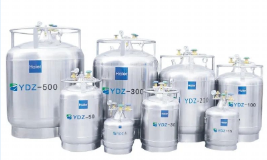With the continuous development of science and technology, liquid nitrogen containers are playing an increasingly important role in all walks of life. In the biomedical field, they are used for long-term storage of vaccines, cells, bacteria, and animal organs, allowing the scientists to take them out and to thaw and rewarm them for use when conditions are ideal. The metal manufacturing industry uses liquid nitrogen stored in liquid nitrogen containers for the cryogenic treatment of metal materials so that their hardness, strength, and wear resistance can be significantly improved. In the animal husbandry field, liquid nitrogen containers are mainly used for the vital preservation and long-distance transportation of animal semen.
However, liquid nitrogen evaporates as it is used, so it is necessary to replenish liquid nitrogen in the containers timely to ensure the secure storage of samples. How to fill liquid nitrogen into the liquid nitrogen containers safely and efficiently? Haier Biomedical’s self-pressurized liquid nitrogen containers provide an answer to this problem.

Haier Biomedical’s self-pressurized liquid nitrogen container mainly comprises a technologically advanced shell, an inner tank, a transport trolley, a drain tube, various valves, a pressure gauge and a vacuum sealing joint, etc. When the inner tank is filled with liquid nitrogen, the vent valve, the drain valve, and the pressurizing valve are closed, and the plug of the liquid nitrogen injection port is tightened. When the above parts are leak-free, due to the heat transfer of the container shell to the pressurizing tube, some of the liquid nitrogen entering the tube will be vaporized by endothermic heat.
When the pressurizing valve is opened, the vaporized nitrogen passes through the valve and immediately enters the space above the liquid surface inside the inner tank. In the meantime, the liquid nitrogen in the container constantly enters the pressurizing tube for endothermal gasification. As the volume of vaporized nitrogen is more than 600 times that of liquid nitrogen, a small amount of liquid nitrogen will produce a large amount of nitrogen upon vaporization, which flows through the opened valve into the inner tank continuously. As the amount of nitrogen entering the tank increases, nitrogen built up in the space above the liquid surface begins to exert pressure on the wall and the surface of the inner tank. When the pressure gauge reading reaches 0.02MPa, the drain valve will be opened, and liquid nitrogen will enter other liquid nitrogen containers smoothly through the drainpipe.
Haier Biomedical’s self-pressurized liquid nitrogen containers range from 5 to 500 liters in storage capacity. All of them are designed with a stainless-steel structure, integrated security mechanism, and relief valve to ensure security while enabling user-friendly operations. For now, Haier Biomedical’s self-pressurized liquid nitrogen containers have been widely used in the mold industry, animal husbandry, medicine, semiconductor, aerospace, military, and other industries, and fields and won unanimous recognition from customers.
As the leader in the biomedical and life science industry, Haier Biomedical always adheres to the concept of “Make Life better” in mind and strives for innovation empowerment. Moving forward, Haier Biomedical will continue to deliver more advanced scenario solutions to help build a common community for human health and help the development of life science.
Original Source: https://www.haiermedical.com/news/HBs-Self-Pressurized-Liquid-Nitrogen-Container.html
Media Contact
Company Name: Haier Biomedical
Email: Send Email
Phone: +86-532-88935593
Country: China
Website: https://www.haiermedical.com/
